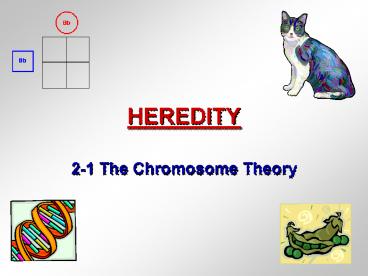HEREDITY - PowerPoint PPT Presentation
1 / 23
Title:
HEREDITY
Description:
... in 1902 was doing research on grasshopper chromosomes. ... Each of a grasshopper's sex cells. contains 12 chromosomes, or. half the number in body cells. ... – PowerPoint PPT presentation
Number of Views:38
Avg rating:3.0/5.0
Title: HEREDITY
1
HEREDITY
- 2-1 The Chromosome Theory
2
INTRODUCTION
- The work of Gregor Mendel provided many early
solutions to the riddle of genetics however, he
did not have all of the answers. - Mendel did not know where the hereditary factors,
or genes, are located in the cell. - The first clue came in 1882 when the German
biologist Walther Flemming discovered chromosomes.
3
INTRODUCTION
- Chromosomes are rod-shaped structures that are
found in the nucleus of every cell in an
organism. - The next clue was provided by Walter Sutton, an
American graduate student who in 1902 was doing
research on grasshopper chromosomes. - From his work, Sutton concluded that chromosomes
carried Mendels hereditary factors, or genes,
from one generation to the next.
4
Grasshoppers have 24 chromosomes, arranged in 12
pairs.
5
Each of a grasshopper's sex cells contains 12
chromosomes, or half the number in body cells.
6
12
12
24
7
INTRODUCTION
- In other words, genes are located on chromosomes.
- Suttons idea came to be known as the chromosome
theory of heredity. - According to the chromosome theory, genes are
carried from parents to their offspring on
chromosomes.
8
Chromosomes and Genes
- Today, scientists know that chromosomes play an
essential role in heredity. - Chromosomes control all the traits of an
organism. - The main function of genes on chromosomes is to
control the production of substances called
proteins. - Proteins determine the size, shape, and other
physical characteristics of an organism.
9
Chromosomes and Genes
- The kind and number of proteins in an organism
determine the traits of that organism. - So by controlling the kind and number of proteins
produced in an organism, chromosomes are able to
determine the traits of that organism.
10
Chromosomes and Genes
- Chromosomes are found in pairs within the nucleus
of a cell. - For any particular trait, the gene contributed by
one parent is on one of the paired chromosomes. - The other gene for that trait, contributed by the
other parent, is on the second chromosome of the
pair. - Each genes major role is to control the
production of a specific protein.
11
(No Transcript)
12
(No Transcript)
13
(No Transcript)
14
Meiosis
- The process of meiosis produces the sex cells,
the sperm or egg cells. - As a result of meiosis, the number of chromosomes
(and genes that they carry) in each sex cell is
half the normal number of chromosomes found in
the parent. - When the sex cells combine to form the offspring,
each sex cell contributes half the normal number
of chromosomes. - Thus, the offspring gets the normal number of
chromosomes half from each parent.
15
(No Transcript)
16
(No Transcript)
17
(No Transcript)
18
Sex Chromosomes
- In 1907, the American zoologist Thomas Hunt
Morgan began his own studies in genetics. - He experimented with insects called fruit flies.
- Morgan quickly discovered something strange about
the fruit flies four pairs of chromosomes. - In female fruit flies, the chromosomes of each
pair were the same shape. - In males, however, the chromosomes of one pair
were not the same shape.
19
Sex Chromosomes
- One chromosome of the pair was shaped like a rod,
and the other chromosome was shaped like a hook. - Morgan called the rod-shaped chromosome the X
chromosome and the hook-shaped chromosome the Y
chromosome. - After performing a number of experiments and
analyzing his results, Morgan discovered that the
X and Y chromosomes determine the sex of an
organism.
20
Sex Chromosomes
- For this reason, the X and Y chromosomes are
called the sex chromosomes. - In general, an organism that has two X
chromosomes (XX) is a FEMALE. - An organism that has one X chromosome and one Y
chromosome (XY) is a male. - An exception female birds are (XY).
21
(No Transcript)
22
(No Transcript)
23
(No Transcript)































